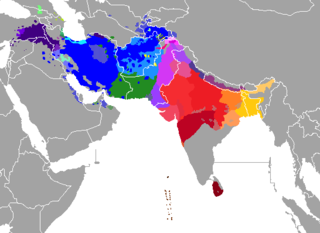
The Indo-Iranian languages constitute the largest and southeasternmost extant branch of the Indo-European language family. They include over 300 languages, spoken by around 1.5 billion speakers, predominantly in South Asia, West Asia and parts of Central Asia.

The Ural Mountains, or simply the Urals, are a mountain range in Eurasia that runs north–south mostly through Russia, from the coast of the Arctic Ocean to the river Ural and northwestern Kazakhstan. The mountain range forms part of the conventional boundary between the continents of Europe and Asia. Vaygach Island and the islands of Novaya Zemlya form a further continuation of the chain to the north into the Arctic Ocean. The average altitudes of the Urals are around 1,000–1,300 metres (3,300–4,300 ft), the highest point being Mount Narodnaya, which reaches a height of 1,894 metres (6,214 ft).
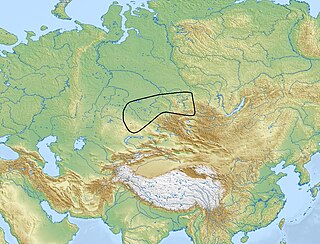
The Karasuk culture describes a group of late Bronze Age societies who ranged from the Aral Sea to the upper Yenisei in the east and south to the Altai Mountains and the Tian Shan in ca. 1500–800 BC.
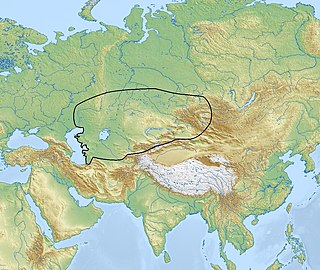
The Andronovo culture is a collection of similar local Late Bronze Age cultures that flourished c. 2000–1150 BC, spanning from the southern Urals to the upper Yenisei River in central Siberia. Some researchers have preferred to term it an archaeological complex or archaeological horizon. The slightly older Sintashta culture, formerly included within the Andronovo culture, is now considered separately to Early Andronovo cultures. Andronovo culture's first stage could have begun at the end of the 3rd millennium BC, with cattle grazing, as natural fodder was by no means difficult to find in the pastures close to dwellings.

Potapovka culture was a Bronze Age culture which flourished on the middle Volga in 2100—1800 BC.

The Abashevo culture is a late Middle Bronze Age archaeological culture, ca. 2200–1850 BC, found in the valleys of the middle Volga and Kama River north of the Samara bend and into the southern Ural Mountains. It receives its name from the village of Abashevo in Chuvashia.
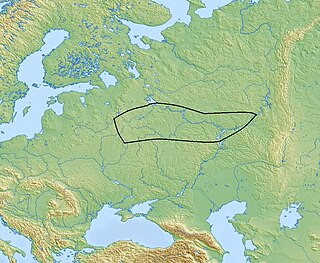
The Fatyanovo–Balanovo culture was a Chalcolithic and early Bronze Age culture within the wider Corded Ware complex which flourished in the forests of Russia from c. 2900 to 2050 BC.
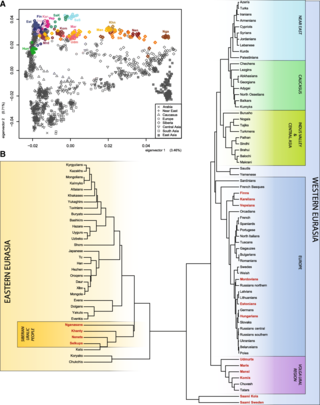
Genetic studies on Sami is the genetic research that have been carried out on the Sami people. The Sami languages belong to the Uralic languages family of Eurasia.
The Tagar culture was a Bronze Age Saka archeological culture which flourished between the 8th and 1st centuries BC in South Siberia. The culture was named after an island in the Yenisei River opposite Minusinsk. The civilization was one of the largest centres of bronze-smelting in ancient Eurasia.

The Prehistory of Siberia is marked by several archaeologically distinct cultures. In the Chalcolithic, the cultures of western and southern Siberia were pastoralists, while the eastern taiga and the tundra were dominated by hunter-gatherers until the Late Middle Ages and even beyond. Substantial changes in society, economics and art indicate the development of nomadism in the Central Asian steppes in the first millennium BC.
Arzhan is a site of early Saka kurgan burials in the Tuva Republic, Russia, some 60 kilometers (40 mi) northwest of Kyzyl. It is on a high plateau traversed by the Uyuk River, a minor tributary of the Yenisei River, in the region of Tuva, 20 km to the southwest of the city of Turan.
Okunev culture, also known as Okunevo culture, was a south Siberian archaeological culture of pastoralists of the early Bronze Age dated from the end of the 3rd millennium BC to the early 2nd millennium BC in the Minusinsk Basin on the middle and upper Yenisei. It was formed from the local Neolithic Siberian forest cultures, who also show evidence of admixture from Western Steppe Herders and pre-existing Ancient North Eurasians.
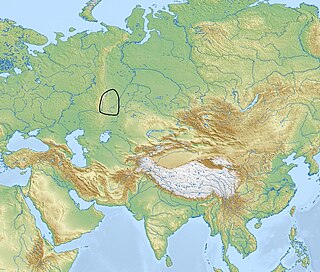
The Sintashta culture is a Middle Bronze Age archaeological culture of the Southern Urals, dated to the period c. 2200–1900 BCE. It is the first phase of the Sintashta–Petrovka complex, c. 2200–1750 BCE. The culture is named after the Sintashta archaeological site, in Chelyabinsk Oblast, Russia, and spreads through Orenburg Oblast, Bashkortostan, and Northern Kazakhstan. Widely regarded as the origin of the Indo-Iranian languages, whose speakers originally referred to themselves as the Aryans, the Sintashta culture is thought to represent an eastward migration of peoples from the Corded Ware culture.

The Proto-Uralic homeland is the hypothetical place where speakers of the Proto-Uralic language lived in a single linguistic community, or complex of communities, before this original language dispersed geographically and divided into separate distinct languages.
The Elunin culture or Elunino culture is an indigenous Bronze Age culture of animal breeders in the steppe and forest-steppe area of the Ob-Irtysh rivers of Ural foothill-plain zone in Siberia, developed from the local Bolshemys Eneolithic culture, dated around 2300–1700 BCE.

Irmen culture is an indigenous Late Bronze Age culture of animal breeders in the steppe and forest steppe area of the Ob river middle course, north of Altai in western Siberia, dated to around the 9th to 8th centuries BCE. Monuments of this advanced bronze-producing culture include numerous settlements and kurgan cemeteries, the culture was named after Irmen kurgan cemetery now flooded by Novosibirsk reservoir. Irmen culture was discovered and described by N.L.Chlenova in 1970.

Karakol culture is a Bronze Age archaeological culture of the 2nd millennium BCE in the Altai area, consecutive to the Afanasiev culture. Karakol culture was discovered in 1985 near village of Karakol in Altai. In the Altai territory, the Bronze Age extended from the 3rd to the 2nd millennium BCE, bronze was a main material for tools, weapons and jewelry. At that time in the Altai territory lived people of the Karakol and Afanasiev cultures. Most of the investigated Karakol culture burials are located on the banks of the river Ursul and its tributaries.

The Krotov culture was an indigenous culture of animal breeders in the steppe and forest-steppe area of the Western Siberia Altai mountainous area of Russia in the upper Irtysh river basin. The Krotov culture embraces the period from the turn of the 3rd and 2nd millenniums to the 13th to 12th centuries BCE. It is a first (pre-Andronovan) period of developed bronze in the Western Siberia. The Krotov culture is an areal period named for a circle of cultures that include Elunin culture, Krotov culture, Loginov culture and similar cultures with identical or close traits and variations. Krotov culture people engaged in cattle breeding, hunting and fishing. In the territory of the culture were found stone and bronze tools.

The Ingala Valley is an archaeological district in the area between the Tobol and Iset rivers. It is the largest one in the south of the Tyumen Oblast, and belongs to the Iset cultural and historical province. It has 177 kurgans, 55 archaeological sites of federal significance and 5 regional natural monuments.
Sargat culture, was a sedentary archaeological culture that existed between 7th century BC and 5th century AD in Western Siberia. Sargat cultural horizon encompassed northern forest steppe zone between the Tobol and Irtysh rivers, which is currently located in Russia and Kazakhstan. The northernmost Sargat culture presence is found near Tobolsk, on the border of the forest zone. In the south, the area of culture coincides with the southern border of the forest-steppe. Eastern foothills of the Urals make up the western boundary of the culture, meanwhile Baraba forest-steppe forms the eastern edge for Sargat settlements and burial grounds. The culture is named after the village of Sargatskoye, which is located near a Sargat burial ground.

















